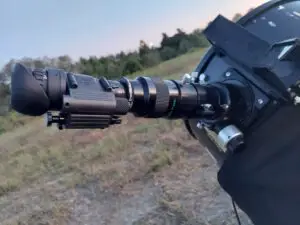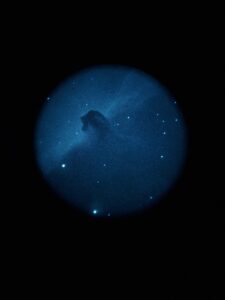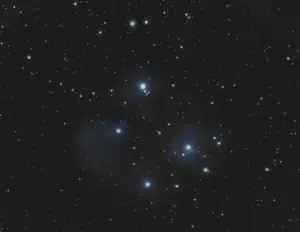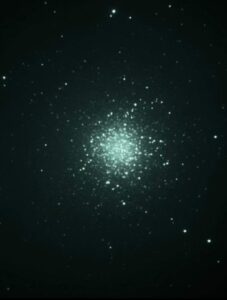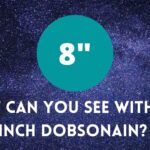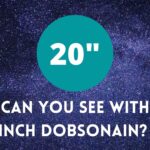Acquiring a 2-inch eyepiece is a big deal for many newcomers to astronomy. But are these hefty, big-barreled oculars truly superior to their 1.25” cousins?
A 2-inch eyepiece is a tool which is well-suited for some tasks, and not so well for others. After fifteen years in this hobby, I still do the bulk of my observing with 1.25” eyepieces, but I always have at least one 2-inch model handy.
Why Do Eyepieces Come in Different Sizes?
The purpose of a 2-inch eyepiece is to accommodate a larger apparent field of view at longer focal lengths.
Eyepieces with longer focal lengths have lower magnification and wider true fields of view than shorter eyepieces. This is similar to what happens when you zoom out with a camera; the view becomes smaller, but you see more of the scene.
However, the view can only get so wide before it is constrained by the field stop inside the eyepiece barrel, and this is where a 2-inch barrel comes into play.
Telescope focusers are standardized to accept certain eyepiece barrel sizes. In former times, this was 0.965”. These days, the standard for entry-level telescopes is 1.25”, and most eyepieces are in this format.
Mid- to high-end telescopes, on the other hand, are often equipped with 2-inch focusers, featuring 1.25” adapters to accept both modern eyepiece formats.
Some even come with 3-inch or larger focusers, but these are targeted at Astrophotographers using large image sensors and serve little purpose for visual astronomy.
What Is the Difference Between 1.25” and 2” Eyepieces?
As I already mentioned, the main functional difference between these eyepieces is the apparent field of view. In most cases, a 2-inch barrel is not so much a performance feature as a design requirement.
| Model | Barrel size | AFOV | Magnification | TFOV | Weight |
| 32mm plossl | 1.25″ | 50 | 37.5 | 1.3 | 6.2 |
| 24mm Panoptic | 1.25″ | 68 | 50 | 1.3 | 8.2 |
| 27mm Panoptic | 2″ | 68 | 44.4 | 1.5 | 16.4 |
| 22mm Nagler | 2″ | 82 | 54 | 1.5 | 24 |
| 17mm Ethos | 2″ | 100 | 70 | 1.4 | 24.8 |
This chart compares various models of Tele Vue eyepieces as viewed through a standard 8-inch Dobsonian (fl 1200mm). AFOV is the perceived width of the field in degrees; TFOV is the actual size of the magnified view. Weight is in ounces.
For instance, if a manufacturer wants a 50-degree apparent field in a 1.25” barrel, the focal length will be confined to around 32mm. Any longer, and the apparent field starts to shrink, meaning you get lower magnification without the benefit of a wider true field.
In a 68-degree eyepiece, this limit is around 24mm. An 82-degree eyepiece in a 1.25” format maxes out around 14mm, and for the recent 100-degree eyepieces the limit is only about 13mm.
If a manufacturer wants to design an eyepiece with a longer focal length while maintaining the same apparent field, a 2-inch barrel will be required.
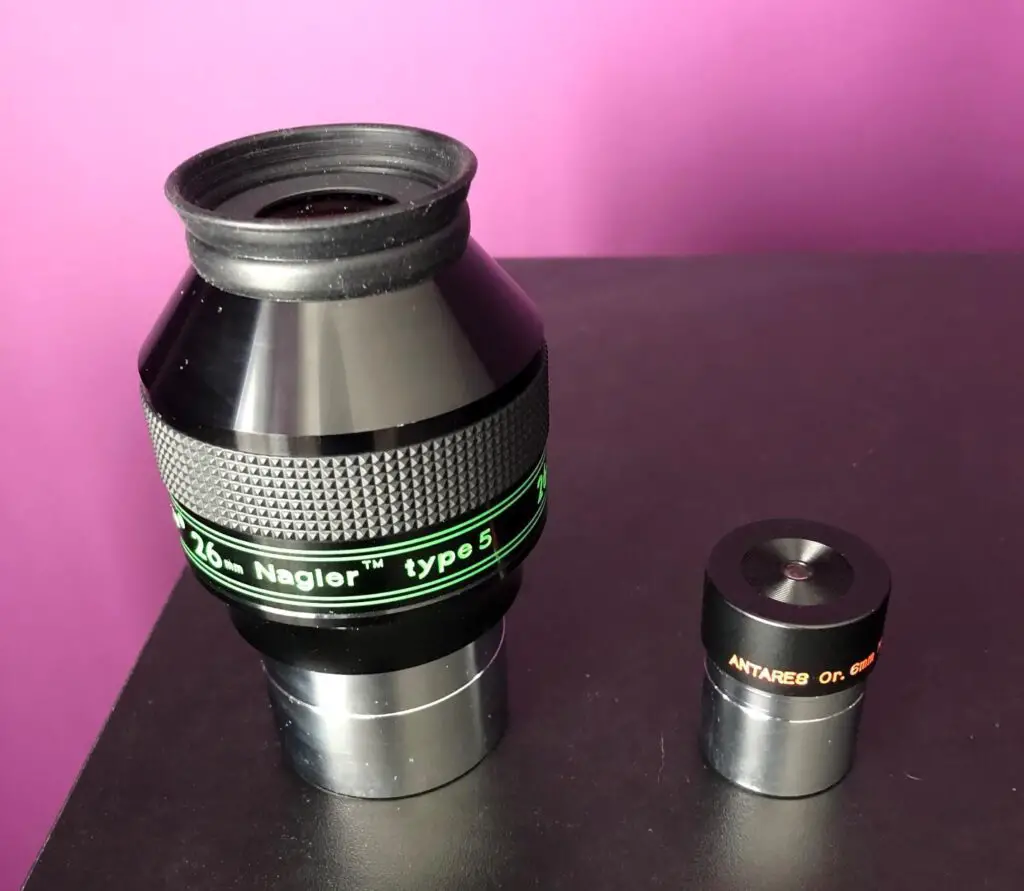
A larger apparent field is not the only difference.
2-inch eyepieces require larger lens elements as well as larger barrel housings, making the eyepieces bulkier and heavier than their 1.25” counterparts.
Inexpensive models tend to suffer from off-axis aberrations, such as coma and astigmatism; to combat this, manufacturers use additional lens elements, at least 5 or 6 and as many as 9, further increasing the size, weight, and cost.
Advantages
Expansive views: The difference between a 25mm plossl, with a 50-degree apparent field, and a 27mm Panoptic with its 68-degree field is astonishing.
Views of wide-field targets such as the Pleiades and Andromeda Galaxy are vastly improved. Sweeping across Milky Way starfields becomes a thrilling experience. The extra-wide field creates what some describe as a “spacewalk” effect, like viewing the sky through a spaceship window rather than through a narrow tube.
Object locating: For owners of manually-driven telescopes, perhaps the biggest advantage of these eyepieces is that their wide fields and low magnification make them ideal to serve as “finders”.
When I had my Orion XT8 reflector, I would always begin my observing session using a 28mm super-wide eyepiece, which made it much easier to locate targets.
Disadvantages
Off-axis aberrations: As with everything in this hobby, you get what you pay for, and a cheap 2-inch eyepiece will quickly reveal its limitations.
Such eyepieces expose aberrations in your telescope’s optics, such as coma and field curvature, while often introducing additional defects like astigmatism, ghosting, and lateral color.
As a result, inexpensive models are usually only sharp in the center of the field.
The degree of off-axis aberrations you notice will depend on several things: the type of eyepiece you buy, the design of your telescope, and even your personal tolerance for imperfections.
In general, “faster” telescopes with low f-ratios are less forgiving when it comes to cheap wide-field eyepieces.
Examples of such eyepieces are mainly variations of the Erfle design: Orion Deepview, Meade QX, and similar eyepieces sold under various brand names.
Size and weight: Premium models from brands such as Tele Vue, Explore Scientific, and Celestron try to get around these limitations by incorporating better glass, and more of it, in their designs.
It is not uncommon for a 2-inch eyepiece to have 7 or 8 lens elements inside its housing. This makes these eyepieces large and, in some cases, quite heavy. Not every telescope can handle this extra weight without upsetting the balance of the mount.
This is especially true of 82-degree or wider designs.
Cost: In addition to more glass elements, premium 2-inch eyepieces also employ more exotic glass to achieve a sharp field with fewer defects. Such eyepieces can easily cost as much as an entry-level telescope, and sometimes several times as much!
What About 1.25”/2” Hybrids?
Some eyepieces have both 1.25” and 2” barrels; or more accurately, they have a 2” collar above the 1.25” barrel.
Some examples are Baader Morpheus, Orion Stratus, and Tele Vue Ethos. Typically, these are wide-angle 1.25” eyepieces which are long and wide enough to accommodate the 2” collar. This allows the eyepiece to be dropped directly into a 2-inch focuser without the need for an adapter, but it is more of a convenience feature rather than a performance enhancer.

Recommendations
With the many eyepiece variations on the market, it can be difficult to decide which is right for you. Here are a few general recommendations to help steer you in a good direction.
For an 8-inch Dobsonian: A good finder eyepiece makes these scopes much more fun to use.
Something in the 28-38mm range, with an apparent field of 65-70 degrees, is a great start. Orion Q70, Explore Scientific 68, and Tele Vue Panoptic are all good choices at their respective price points.

For a short-tube refractor: Short refractors are renowned for their rich-field views, which are further enhanced by a 2-inch eyepiece.
While the above models will work, consider something closer to 25mm to keep the magnification from getting too low.
For an SCT: Cassegrain telescopes require special consideration. Even if equipped with a 2-inch visual back, baffles inside the optical tube restrict the usable field of view and many users prefer to stick with 1.25” eyepieces.
Premium options: The 31mm Nagler Type 5 is considered one of the best there is, but it is mega expensive and very heavy.
More affordable options exist from other manufacturers, and will satisfy the casual observer. For galaxies and clusters, medium-powered models such as Ethos, Explore Scientific 100 degree, and Meade MWA provide increased magnification while maintaining the ultra-wide field.

